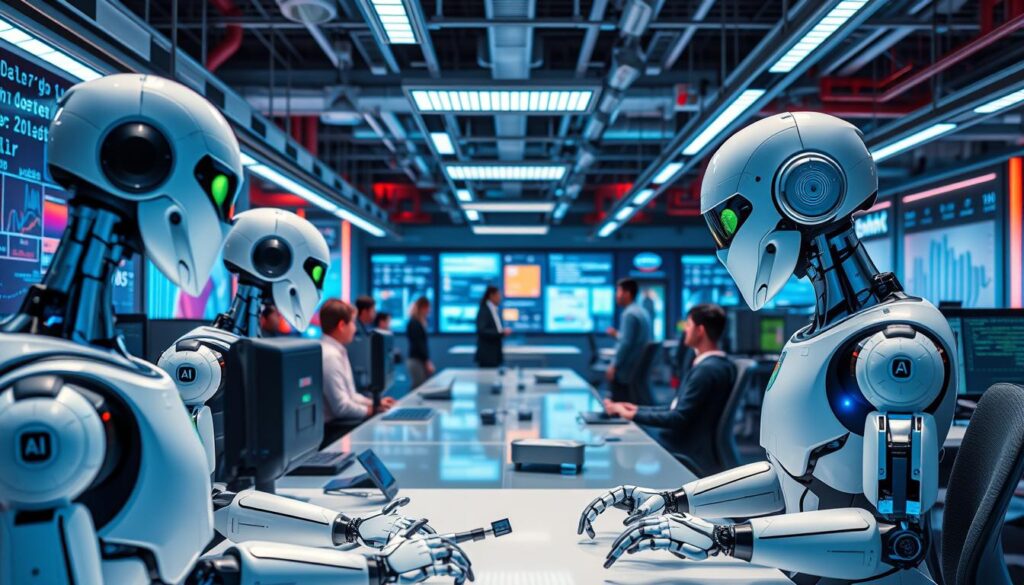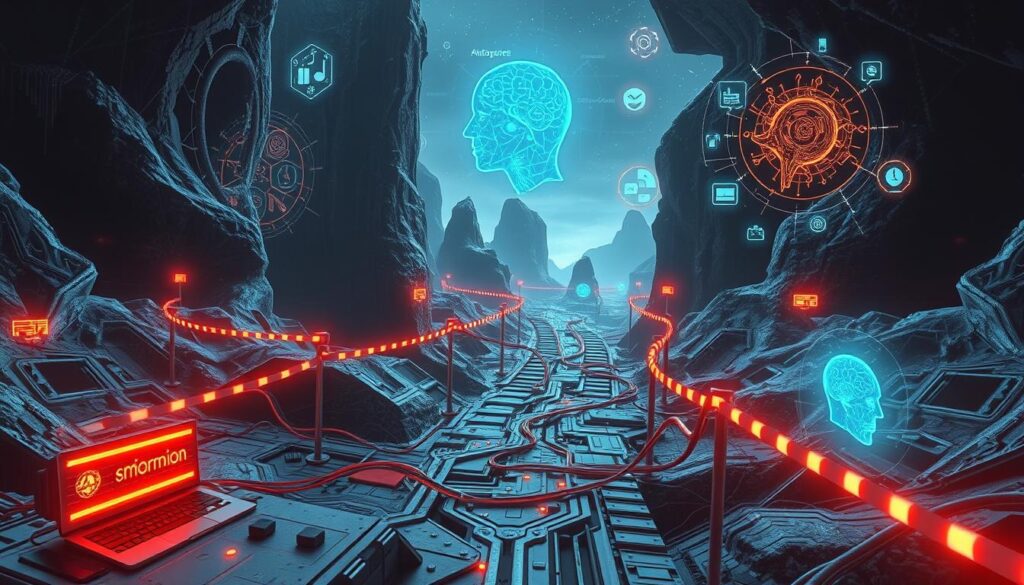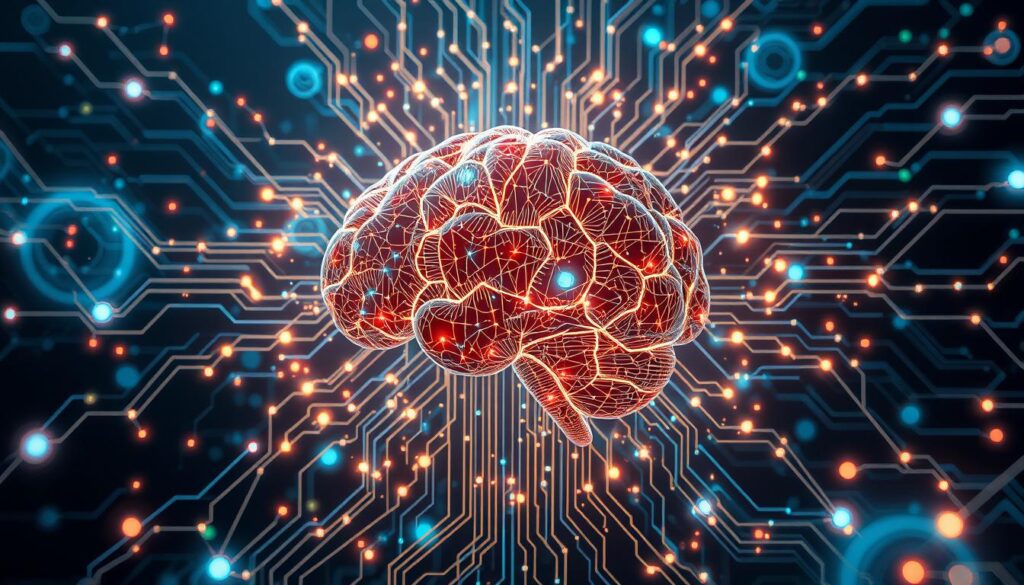Artificial intelligence lets computers think like humans. They can learn, solve problems, and make decisions. This is thanks to computer simulation, which helps them understand and use lots of data.
AI has changed many areas, like healthcare, finance, and transport. It uses computer simulation to think like us. This change is making our lives and work better. AI’s growth and ability to think like us are huge.
Introduction to Artificial Intelligence Concepts
As AI gets better, we need to know how it works. It uses computer simulation to think like us. By learning about AI, we can use it to make things better. This way, AI can help us think better too.
Key Takeaways
- Artificial intelligence uses computer simulation to mimic humanlike thinking
- Artificial intelligence can perform tasks that typically require human intelligence
- Computer simulation enables artificial intelligence systems to process and analyze vast amounts of data
- Artificial intelligence has led to significant advancements in various fields
- Artificial intelligence has the potential to drive innovation and growth
- Understanding artificial intelligence is essential to unlocking its full potential
Introduction to Artificial Intelligence
Artificial intelligence means making computers do things that humans can do. This idea has been around for a long time. Computer scientists have been trying to make machines think and learn like us.
In recent years, artificial intelligence has become very important. It’s used in many areas like healthcare, finance, and transportation.
When making artificial intelligence systems, it’s key to think about how users will interact with them. UI design strategies help make machines easier to use. By using good design, developers can make systems that work well and are simple to use.
Some important parts of artificial intelligence include:
- Machine learning
- Natural language processing
- Neural networks
These technologies help make advanced artificial intelligence systems. These systems can do things like recognize images, understand speech, and make decisions.
As artificial intelligence grows, it will change many parts of our lives. Knowing about artificial intelligence helps us see its good and bad sides. By using user interface design techniques and designing the user interface strategies, we can make systems that are smart and easy to use.
Core Principles of AI Technology
Artificial intelligence technology relies on key principles like machine learning, natural language processing, and neural networks. These allow machines to learn from data, talk to humans naturally, and make choices based on that interaction. By using HCI best practices and interactive design, developers make human-computer interactions better and more effective.
Improving how humans and machines interact is key in AI development. This lets humans talk to machines in a more natural way. User-centered design is important here, focusing on what users need and how they behave. Key points for better human computer interaction include:
- Designing interfaces that are easy to use and understand
- Providing clear and concise feedback to the user
- Allowing users to correct mistakes and recover from errors
By sticking to these principles and guidelines, developers can make AI systems better, more efficient, and easier to use. This can help AI technology get more accepted and used in many areas of life.
How AI Mimics Human Thinking
Artificial intelligence systems have made big steps in mimicking human thinking. They use machine learning algorithms to learn from data. This lets AI find patterns and relationships in data, key for making decisions.
By using user-centered design, AI developers make interfaces more intuitive and effective. This boosts UI usability, making AI systems more accessible and user-friendly.
Effective UI development is key for seamless human-AI interaction. It involves designing interfaces that are simple to use. This lets users input and receive output naturally.
- Learning from data: AI systems can learn from large datasets to identify patterns and relationships.
- Pattern recognition: AI can recognize patterns in data, images, and sounds, which enables it to make predictions and decisions.
- Decision-making processes: AI systems can make decisions based on the data they have learned from, which is critical for applications such as autonomous vehicles and medical diagnosis.
By combining these aspects with user-centered design and effective UI development, AI developers can create systems that are intelligent and easy to use. This is crucial for realizing AI’s full potential and creating systems that truly mimic human thinking.
Applications of AI in Everyday Life
Artificial intelligence has changed how we use technology every day. It’s key to design user interfaces that are easy to use. This makes AI devices and systems more popular and useful.
AI is used in many ways, like virtual assistants and chatbots, and smart home devices. These systems need good user interfaces to work well. For example, virtual assistants like Amazon’s Alexa understand voice commands.
Smart home devices, like thermostats, can be controlled from our phones. This shows how important good user interfaces are in AI. By focusing on design, developers make systems that are easier and more helpful for us.
Some key uses of AI in our lives include:
- Virtual assistants and chatbots for customer support and information retrieval
- Recommendation systems for personalized product suggestions
- Smart home devices for automated home management
These uses are becoming more common. Their design is key to how well they work and how much people use them.
AI in Healthcare
Artificial intelligence is changing healthcare in many ways. It helps with diagnosis and personalized medicine. By using HCI best practices, healthcare can become more effective and easy to use. This makes it easier for doctors to diagnose and treat patients better.
AI in healthcare has many benefits. It leads to better patient care and makes things more efficient. Some key uses include:
- Diagnostic tools that can analyze medical images and identify diseases more accurately and quickly than human doctors
- Personalized medicine, which enables doctors to tailor treatment plans to individual patients based on their genetic profiles and medical histories
- Administrative applications, such as automating tasks like billing and insurance claims
By following HCI best practices and interactive design, healthcare can improve. This makes systems more intuitive and effective. It leads to better patient care.
The healthcare industry will keep evolving with AI and HCI. These technologies help improve patient outcomes and make things more efficient. It’s important to keep researching and developing these technologies. This will help optimize human computer interaction and improve healthcare outcomes.
AI in Business and Industry
Artificial intelligence is changing the business world. It automates tasks, improves decision-making, and boosts customer relationships. Companies need to use user-centered design strategies for simplicity and ease of use.
To make AI work well, we must improve how humans and machines interact. This means creating interfaces that are both useful and nice to look at. This is done through effective UI development practices.
Key Applications of AI in Business
- Automation of tasks: AI can do repetitive tasks, letting humans focus on creative work.
- Predictive analytics: AI helps predict trends, guiding businesses to make smart choices.
- Customer relationship management: AI CRM systems make customer interactions more personal, enhancing the experience.

By using AI and user-centered design strategies, businesses can grow, innovate, and stay competitive.
Ethical Considerations in AI Development
Artificial intelligence is growing fast, and we must think about its ethics. It’s key to design user interfaces that let humans work well with AI. This means making UIs that are clear, fair, and focus on the user. This way, AI can be both useful and respectful of our values and privacy.
Important ethical points in AI development include:
- Data privacy concerns: AI uses lots of personal data, which makes us worry about keeping it safe.
- Bias in AI algorithms: If AI learns from biased data, it can act unfairly and discriminate.
- Accountability and transparency: It’s crucial for AI to be open and fair in its decisions so we can trust it.
To make AI systems that are both good and fair, we need to focus on design. We should aim for clear, fair, and user-focused interfaces. This means understanding how humans and machines interact with data. It also means making AI that cares about our well-being and dignity.
Future Trends in AI Technology
AI technology is growing fast, with big steps in deep learning and combining with other tech. Optimizing human computer interaction is key. It helps us work better with machines.
By using HCI best practices and interactive design principles, AI can become easier to use. This will make AI more popular and useful in many fields.
Advancements in Deep Learning
Deep learning lets AI systems learn from lots of data and get better over time. As it improves, AI will be more accurate and efficient.
Integration with Other Technologies
AI will team up with the Internet of Things and blockchain. This mix will change many industries and society. Together, they’ll make systems more powerful and efficient.
Potential Societal Impacts
AI’s effects on society are big and varied. It might change jobs, work, and even make social gaps worse. As AI grows, we must think about these effects and find ways to lessen them.
Challenges Facing AI Implementation
AI technology is getting better, but it faces many challenges. One big issue is the lack of standardization and how different systems work together. This can be solved by focusing on user-centered design strategies. By putting users first, developers can make interfaces that are easier to use and more effective.
Another big challenge is the rules and laws around AI. Clear rules are needed for AI to be widely accepted. Effective UI development practices can help by making AI systems clear, explainable, and fair.

- Technical issues, like the quality of data and bias in algorithms
- Rules and standards needed for AI to grow
- How people see AI, which can be changed with user-centered design strategies and enhancing UI usability
By facing and solving these problems, developers can make AI systems that are better and more user-friendly. This will help AI grow and bring new ideas to the table.
The Role of Education in AI
Education is key in the growth and use of artificial intelligence. As AI enters our daily lives, we need a skilled workforce. They must be able to design and work with AI systems. This includes designing the user interface strategies for better human-machine interaction.
AI literacy is crucial for everyone. It helps people grasp the basics of AI and its uses.
AI Literacy for the General Public
is vital for making smart choices about AI. It ensures people understand AI’s role in their lives. This can be done withUI design strategies that focus on simplicity and ease of use.
Training Programs in AI and Data Science
are vital for building AI skills. These programs should cover user interface design techniques and more. They help make AI development inclusive and diverse.
Lastly,
Initiatives for Diverse Talent in AI Fields
are essential for inclusive AI development. They promote diversity and inclusion in AI education. This leads to a fair and effective AI industry.
Conclusion: The Future of AI and Human Collaboration
Artificial intelligence (AI) is changing our lives in big ways. It’s making virtual assistants and personalized healthcare possible. But AI’s real power is in working with humans, making us stronger together.
Optimizing Human-Computer Interaction
Good human-AI teamwork starts with easy-to-use designs. By following best practices, we can make AI fit smoothly into our lives. This way, we can use AI’s power without losing control.
Embracing AI Literacy
Understanding AI is key to using it well. We need more AI education to help people make smart choices. This way, we can all play a part in the future of AI and humans working together.
A Call to Action
We’re at a turning point with AI. It’s time for everyone to work together. Researchers, policymakers, tech experts, and citizens must ensure AI is developed ethically and for everyone. By doing this, we can unlock a future where humans and machines work together, bringing about new opportunities and a better world.
FAQ
What are the core principles of AI technology?
AI technology is based on machine learning, natural language processing, and neural networks. Machine learning lets machines get better with time by learning from data. Natural language processing helps computers understand and talk to humans in their own language. Neural networks are inspired by the brain and are a key part of machine learning.
How does AI mimic human thinking?
AI mimics human thinking by learning from data and recognizing patterns. It makes decisions based on what it learns. This way, AI can solve problems and make choices like humans do.
What are some everyday applications of AI?
AI is used in many ways we see every day. Virtual assistants and chatbots help us with tasks. Recommendation systems suggest things we might like. Smart home devices make our homes more comfortable and efficient.
How is AI used in healthcare?
AI helps in healthcare by improving diagnosis and treatment. It can look at medical images and find diseases faster than doctors. AI also helps with personalized medicine and makes administrative tasks easier.
What are the ethical considerations in AI development?
Ethical issues in AI include privacy, bias, and accountability. AI uses a lot of personal data, which raises privacy concerns. Bias in AI can lead to unfair outcomes. It’s important for AI to be transparent and accountable.
What are the future trends in AI technology?
Future AI trends include better deep learning and integration with other technologies. Deep learning helps AI learn from lots of data. AI combined with the Internet of Things and blockchain will change many industries. But, AI might also change jobs and how we work.
What are the challenges facing AI implementation?
Challenges in AI include technical issues, regulatory problems, and public acceptance. Technical problems like standardization can slow AI adoption. Regulatory hurdles and public acceptance are also big challenges. How people feel about AI affects its use and adoption.
